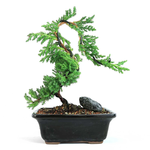Dadayama
Sapling
I was searching the archives and was surprised that this question has not come up...
A bonsai is a potted tree that is grown using artistic and horticultural techniques in pursuit of an artistic image for the viewer. They are grown with intent. Intent other than simple foliage. A potted plant is a potted plant.I was searching the archives and was surprised that this question has not come up...

Beauty is in the eye of the beholder, meaning that if you feel good calling that procumbens whip a bonsai, then it's fine... and technically, it's accurate. With that being said, the vast majority of bonsai enthusiasts would balk at calling that a 'good' bonsai. In fact, the image you've provided has colloquially been labeled a 'mallsai'- cheap bonsai mass produced to be sold to the masses who don't know any better. A 'mallsai' was actually my first bonsai, a Christmas gift over half a life time ago,Hello everyone
Thank you for all the answers and especially MaciekA for the in-depth analysis.
It is interesting how so many of the answers steered towards a scientific or dictionary response. The direct response is in no way bad it is just that I meant to ask the question with a more philosophical approach. That was my fault for not reflecting my intent very well.
What prompted my question is I often see on the "net" or at commercial plant establishments trees that appear to my sapling eyes, as simply young trees stuck in pots.
View attachment 503721
Here is an example of what I mentioned above. To my patron of bonsai eyes (as opposed to bonsai practitioner) this looks like a baby tree with wire attached and bent whimsically.
Is this image bonsai or not? It is being sold online as bonsai and I wouldn't want to take the enjoyment away from one who purchases this tree. But, mentally I have a hard time excepting this as bonsai and more as something sold to resemble bonsai.
Am I a bad person for thinking this way?
I don't know why this irritates me so much... but... BONSAI IS NOT A VERB!Bonsai is a verb
Here is an example of what I mentioned above. To my patron of bonsai eyes (as opposed to bonsai practitioner) this looks like a baby tree with wire attached and bent whimsically.
Is this image bonsai or not? It is being sold online as bonsai and I wouldn't want to take the enjoyment away from one who purchases this tree. But, mentally I have a hard time excepting this as bonsai and more as something sold to resemble bonsai.
